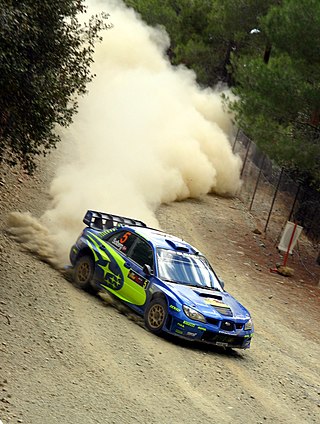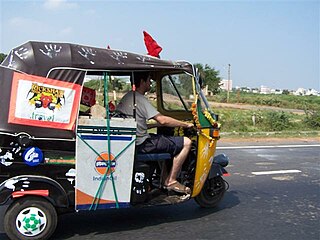
The Dakar Rally or simply "The Dakar", formerly known as the "Paris–Dakar Rally", is an annual rally raid organised by the Amaury Sport Organisation. Most events since the inception in 1978 were staged from Paris, France, to Dakar, Senegal. Security threats in Mauritania led to the cancellation of the 2008 rally, and events from 2009 to 2019 were held in South America. Since 2020, the rally has been held in Saudi Arabia. The event is open to amateur and professional entries, professionals typically making up about eighty percent of the participants.

Rallying is a wide-ranging form of motorsport with various competitive motoring elements such as speed tests, navigation tests, or the ability to reach waypoints or a destination at a prescribed time or average speed. Rallies may be short in the form of trials at a single venue, or several thousand miles long in an extreme endurance rally.

Ulaanbaatar, previously anglicized as Ulan Bator, is the capital and most populous city of Mongolia. It has a population of 1.6 million, and it is the coldest capital city in the world by average yearly temperature. The municipality is located in north central Mongolia at an elevation of about 1,300 metres (4,300 ft) in a valley on the Tuul River. The city was founded in 1639 as a nomadic Buddhist monastic centre, changing location 28 times, and was permanently settled at its modern location in 1778.

The Plymouth-Banjul Challenge is run by 'Dakar Challenge' and self described as 'The original Banger Challenge’ and previously known as the Plymouth-Dakar Challenge, is an annual car event for charity. Established in 2002, the first rally went to Dakar in 2003, and then on to Banjul from 2005. It very roughly follows the route of the more famous Dakar Rally, visiting many of the same countries.

Gumball 3000 is a brand known for the annual Gumball 3000 Rally, an international celebrity motor rally that takes place on public roads. The brand was founded in 1999 by English entrepreneur Maximillion Cooper, with his vision to combine cars, music, fashion and popular culture.

The Daihatsu Charade is a supermini car produced by the Japanese manufacturer Daihatsu from 1977 to 2000. It is considered by Daihatsu as a "large compact" or "supermini" car, to differentiate it from the smaller kei car compacts in its line-up, such as the Daihatsu Mira. In Japan, it offers buyers more interior space and a larger engine that allows for the car to also be used outside of urban areas. It replaced the Daihatsu Consorte, although the Charmant took over from the bigger-engined Consortes, and didn't share a platform with a Toyota product.
The London to Peking Motor Challenge was a one-time car rally organized by the Jules Verne Society in the Spring of 1990.

The Peking to Paris motor race was an automobile race, originally held in 1907, between Peking, then Qing China and Paris, France, a distance of 14,994 kilometres (9,317 mi).

The Rickshaw Run is an event where teams drive Auto Rickshaws along various routes across India. The first route in December 2006 was from Kochi, in the southern state of Kerala, to Darjeeling, in West Bengal. In its inaugural run, 34 teams started the event, and 31 of those finished. The rickshaw run has involved dangerous road incidents occurring during the 'race'.

Rodney Kenneth Millen is a New Zealand racing driver, vehicle designer, and business owner. He has competed in numerous genres of motorsports, including rallying, off-road racing, hillclimbing, drifting, and super touring.
A charity rally is a charitable event in which participants usually drive, ride or otherwise participate in through the medium of motorised wheeled transportation in an event to raise money for a charitable cause.

The Mongolia Charity Rally is the charity rally from London to the capital of Mongolia, Ulaanbaatar. The Mongolia Charity Rally is organised by Charity Rallies, part of Go Help, a UK-based charity.
The Scumrun is an annual charitable event in the form of a road rally from the United Kingdom to mystery destinations around Europe. It has been running since 2006, originally as the Scumball 3000.
Liège-Brescia-Liège is a motorsports rallying event organised once in 1958 and recreated as a historic rally in 2008 and subsequently.
The Silk Road Race is a charity rally from Milan to the capital of Tajikistan, Dushanbe. The Silk Road Race is organised by Partenza Intelligente, a non-profit cultural association based in Lainate (Milan), Italy. The first edition of the rally was launched on 31 July 2010.

The Silk Way Rally is an annual rally raid held in Russia and neighbouring countries. The first Silk Way Rally was run in 2009 from Kazan, Russia, to Ashgabat, Turkmenistan. It is organised by the Silk Way Rally Association.
The Mongol Derby is an equestrian endurance race. It extends 1,000 kilometres (620 mi) through the Mongolian Steppe and is the world's longest horse race. The course recreates the horse messenger system developed by Genghis Khan in 1224.
The Shitbox Rally is a long-distance motoring event run in Australia as a fundraiser for cancer research charities, originally an annual event but increased to twice-yearly in 2019.

Chris Ramsey is a British adventurer and sustainable living advocate. Julie and Chris Ramsey became the first people to drive the Mongol Rally in an electric vehicle.

The Grand Henham Steam Rally is a steam rally held every September at Henham Park near Southwold. It features displays of fixed and mobile steam engines and of vintage and classic cars and motorcycles. There are many events and activities, and craft, trade and food stalls. Proceeds are given to local charities. The organiser was forced into liquidation in July 2020.



















